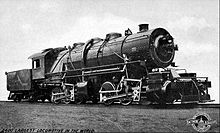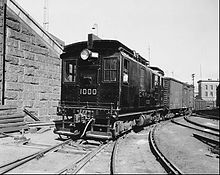
The Mallet locomotive is a type of articulated steam railway locomotive, invented by the Swiss engineer Anatole Mallet (1837–1919).

Baldwin Locomotive Works (BLW) was an American manufacturer of railway locomotives from 1825 to 1951. Originally located in Philadelphia, Pennsylvania, it moved to nearby Eddystone in the early 20th century. The company was for decades the world's largest producer of steam locomotives, but struggled to compete when demand switched to diesel locomotives. Baldwin produced the last of its 70,000-plus locomotives in 1951, before merging with the Lima-Hamilton Corporation on September 11, 1951, to form the Baldwin-Lima-Hamilton Corporation.

A 2-8-8-4 steam locomotive, under the Whyte notation, has two leading wheels, two sets of eight driving wheels, and a four-wheel trailing truck. The type was generally named the Yellowstone, a name given it by the first owner, the Northern Pacific Railway, whose lines ran near Yellowstone National Park. Seventy-two Yellowstone-type locomotives were built for four U.S. railroads.

The New York Central Hudson was a popular 4-6-4 "Hudson" type steam locomotive built by the American Locomotive Company (ALCO), Baldwin and the Lima Locomotive Works in three series from 1927 to 1938 for the New York Central Railroad. Named after the Hudson River, the 4-6-4 wheel arrangement came to be known as the "Hudson" type in the United States, as these locomotives were the first examples built and used in North America. Built for high-speed passenger train work, the Hudson locomotives were famously known for hauling the New York Central's crack passenger trains, such as the 20th Century Limited and the Empire State Express. With the onset of diesel locomotives by the mid-20th Century, all Hudson locomotives were retired and subsequently scrapped by 1957, with none preserved today except for a converted tender from J-1d 5313, which is preserved at the Steamtown National Historic Site in Scranton, Pennsylvania.

Under the Whyte notation for the classification of locomotives, 4-6-4 represents the wheel arrangement of four leading wheels, six powered and coupled driving wheels and four trailing wheels. In France where the type was first used, it is known as the Baltic while it became known as the Hudson in most of North America.
The UIC classification of locomotive axle arrangements, sometimes known as the German classification or German system, describes the wheel arrangement of locomotives, multiple units and trams. It is used in much of the world, notable exceptions being the United Kingdom, which uses a slightly simplified form of UIC, and in North America, where the AAR wheel arrangement system is used to describe diesel and electric locomotives. In North America, Whyte notation is only used for steam locomotives.
Under the Whyte notation for the classification of steam locomotives, 2-10-2 represents the wheel arrangement of two leading wheels, ten powered and coupled driving wheels, and two trailing wheels. In the United States of America and elsewhere the 2-10-2 is known as the Santa Fe type, after the Atchison, Topeka and Santa Fe Railway that first used the type in 1903.
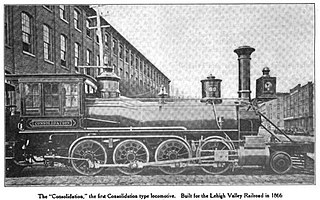
Under the Whyte notation for the classification of steam locomotives, 2-8-0 represents the wheel arrangement of two leading wheels on one axle, usually in a leading truck, eight powered and coupled driving wheels on four axles, and no trailing wheels. In the United States and elsewhere, this wheel arrangement is commonly known as a Consolidation, after the Lehigh and Mahanoy Railroad’s Consolidation, the name of the first 2-8-0.

An articulated locomotive is a steam locomotive with one or more engine units that can move independent of the main frame. Articulation allows the operation of locomotives that would otherwise be too large to negotiate a railroad's curves, whether mainlines or special lines with extreme curvature such as logging, industrial, or mountain railways.
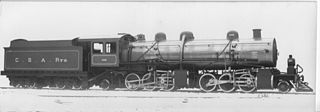
Under the Whyte notation for the classification of steam locomotives by wheel arrangement, a 2-6-6-2 is a locomotive with one pair of unpowered leading wheels, followed by two sets of three pairs of powered driving wheels and one pair of trailing wheels. The wheel arrangement was principally used on Mallet-type articulated locomotives, although some tank locomotive examples were also built. A Garratt type locomotive with the same wheel arrangement is designated 2-6-0+0-6-2.

The 2-6-6-6 is an articulated locomotive type with two leading wheels, two sets of six driving wheels and six trailing wheels. Only two classes of the 2-6-6-6 type were built. One was the "Allegheny" class, built by the Lima Locomotive Works. The name comes from the locomotive's first service with the Chesapeake and Ohio Railway beginning in 1941, where it was used to haul loaded coal trains over the Allegheny Mountains. The other was the "Blue Ridge" class for the Virginian Railway. These were some of the most powerful reciprocating steam locomotives ever built, at 7,500 hp, and one of the heaviest at 386 tons for the locomotive itself plus 215 tons for the loaded tender.
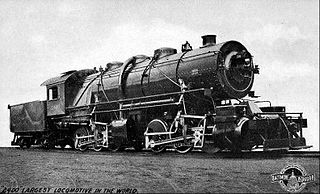
Under the Whyte notation for the classification of steam locomotives, a 0-6-6-0 wheel arrangement refers to a locomotive with two engine units mounted under a rigid locomotive frame, with the front engine unit pivoting and each engine unit with six coupled driving wheels without any leading or trailing wheels. The wheel arrangement was mostly used to describe Mallet locomotive types.

Dieselisation is the process of equipping vehicles with a diesel engine or diesel engines. It can involve replacing an internal combustion engine powered by petrol fuel with an engine powered by diesel fuel, as occurred on a large scale with trucks, buses, farm tractors, and building construction machinery after the Second World War. Alternatively it can involve replacing the entire plant or vehicle with one that is diesel-powered; the term commonly describes the generational replacement between the 1930s and the 1970s of railway steam locomotives with diesel locomotives, and associated facilities.
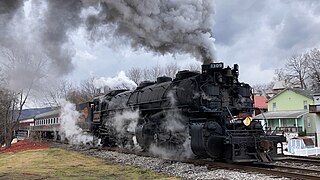
The USRA 2-6-6-2 is a standardized design of 2-6-6-2 Mallet locomotives developed by the United States Railroad Administration during World War I.
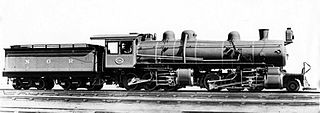
The South African Railways Class MA 2-6-6-0 of 1909 was a steam locomotive from the pre-Union era in the Natal Colony.
Maine Central Railroad Class O locomotives were originally intended for heavy freight service. They were of 4-6-0 wheel arrangement in the Whyte notation, or "2'C" in UIC classification. They replaced earlier class P 2-6-0 locomotives beginning in 1903. They were in turn replaced by class W 2-8-0 locomotives for the heaviest freight service beginning in 1910, but remained in use on branch line trains until replaced by diesel locomotives after World War II. They proved so well-suited for branch line service the design was among the last steam locomotives built for the Maine Central.

The Baltimore and Ohio’s P-7 class was a class of 20 Pacific type locomotives built in 1927. Named for the first 20 Presidents of the United States, they were the prime motive power for the B&O’s top passenger trains for 31 years. One example, Baltimore and Ohio 5300, the "President Washington", has been preserved.

Baltimore and Ohio 4500 is a 2-8-2 "USRA Light Mikado" steam locomotive built by the Baldwin Locomotive Works in Philadelphia, Pennsylvania in July 1918 for the Baltimore and Ohio Railroad (B&O) as a member of the Q-3 class.

Western Maryland Scenic Railroad No. 734, also known as Mountain Thunder, is a preserved class "SC-1" 2-8-0 "Consolidation" type steam locomotive originally built by the Baldwin Locomotive Works in 1916 for the Lake Superior and Ishpeming Railroad. The locomotive was built for service as a dock switcher and was originally LS&I No. 18. In 1923, the LS&I purchased the Munising, Marquette & Southeastern Railroad and the engine was renumbered to No. 34. It served the LS&I until it was retired from revenue service in 1961. In 1963, it was sold to the Marquette and Huron Mountain Railroad, but never operated under the M&HR flag. In 1971, the locomotive was sold to the Illinois Railway Museum for static display. Since 1991, No. 734 has been owned by the Western Maryland Scenic Railroad in Cumberland, Maryland, though it has not operated since April 2016. It is currently awaiting evaluation for potential overhaul.
Baltimore and Ohio No. 5300, also known as President Washington, is the sole survivor of the P-7 class 4-6-2 "Pacific" type steam locomotives. It was built by Baldwin in 1927, and it was used on mainline passenger trains across the Baltimore and Ohio system, particularly the Royal Blue train, until it was retired in 1957. After being stored for a few years, it was donated to the Baltimore and Ohio Railroad Museum in Baltimore, Maryland, where it has spent several years on static display. The locomotive is undergoing a cosmetic restoration, as of 2023.

